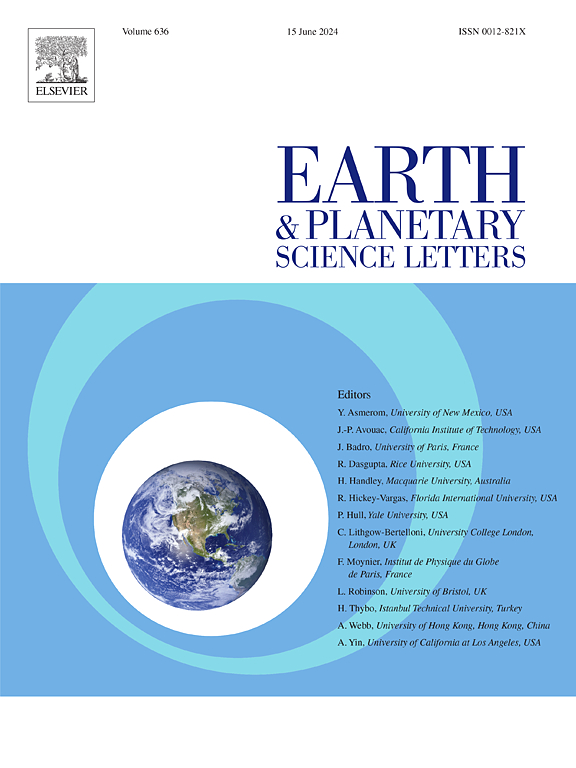Potential formational scenarios of the mud volcanoes in the Zhurong landing area in Utopia Planitia, observed by Tianwen-1
IF 4.8
1区 地球科学
Q1 GEOCHEMISTRY & GEOPHYSICS
引用次数: 0
Abstract
The widely distributed pitted cones in Utopia Planitia have several explanations, and they have been interpreted as mud volcanoes in the Zhurong landing area. The morphology and distribution characteristics of mud volcano cones can serve as indicators of stress direction and can also be used to calculate potential depth for mud sources. This information may assist in elucidating the potential formational scenarios of the mud volcanoes, which is of great significance to study the tectonic evolution in Utopia Planitia and possible water ice depths. The digital orthophoto map (DOM) and the digital elevation model (DEM) with spatial resolutions of 0.7 m and 3 m obtained by High Resolution Imaging Camera (HiRIC) from Tianwen-1 show that the mud volcanoes are distributed as both isolated cones and clustered cones in the Zhurong landing area. The age of the mud volcanoes is limited to the middle to late Amazonian (∼2.0 Ga - 400 Ma) based on the crater size-frequency distribution (CSFD); the depth range of the mud source is estimated to be ∼0.6–7.2 km by self-similar clustering analysis. The orientations of the aligned cones and the elongated mud vents indicate that the maximum horizontal stress (SH) directions during the formation of the mud volcanoes in the landing area are in the direction of N67°E, which is in good agreement with the orientations of the nearby troughs, suggesting that the formation of the mud volcanoes in the landing area may have been controlled by the fracturing of the lower part of the troughs. These features, compared with those reported in previous study of mud volcanism/cone morphology on Mars, collectively suggest that the mud volcanoes in the landing area may have formed in a geological scenario under conditions of volcanic destabilization. Further, the formation of the mud volcanoes, with the analysis of the SH, may have been influenced by both basin subsidence and the volcanism in the Elysium region. This study provides a new example of Martian mud volcano geologic formation scenarios, offers the feasibility of using the SH to analyze Martian mud volcano formation, and hints at active geologic phenomena on Mars during the Amazonian period.
天文一号观测到的桃花源行星祝融着陆区泥火山的潜在形成情况
乌托邦星广泛分布的凹陷锥体有多种解释,它们被解释为祝融着陆区的泥火山。泥火山锥体的形态和分布特征可以作为应力方向的指标,也可用于计算泥源的潜在深度。这些信息有助于阐明泥火山的潜在形成情况,对研究桃花江地块的构造演化和可能的水冰深度具有重要意义。天文一号高分辨率成像相机(HiRIC)获得的空间分辨率分别为0.7米和3米的数字正射影像图(DOM)和数字高程模型(DEM)显示,泥火山在祝融着陆区以孤立锥体和群集锥体两种形式分布。根据火山口大小-频率分布(CSFD),将泥火山的年龄限定在亚马逊中晚期(∼2.0 Ga - 400 Ma);通过自相似聚类分析,估计泥源的深度范围为∼0.6-7.2 km。从排列的圆锥体和拉长的泥喷口的方向来看,着陆区泥火山形成过程中的最大水平应力(SH)方向为N67°E,这与附近海槽的走向十分吻合,表明着陆区泥火山的形成可能受海槽下部断裂的控制。这些特征与以往火星泥火山/火山锥形态研究中报告的特征相比,共同表明着陆区的泥火山可能是在火山不稳定的地质条件下形成的。此外,根据对SH的分析,泥火山的形成可能受到了盆地沉降和极乐地区火山活动的影响。这项研究为火星泥火山地质形成情景提供了一个新的实例,提供了利用SH分析火星泥火山形成的可行性,并暗示了亚马逊时期火星上活跃的地质现象。
本文章由计算机程序翻译,如有差异,请以英文原文为准。
求助全文
约1分钟内获得全文
求助全文
来源期刊

Earth and Planetary Science Letters
地学-地球化学与地球物理
CiteScore
10.30
自引率
5.70%
发文量
475
审稿时长
2.8 months
期刊介绍:
Earth and Planetary Science Letters (EPSL) is a leading journal for researchers across the entire Earth and planetary sciences community. It publishes concise, exciting, high-impact articles ("Letters") of broad interest. Its focus is on physical and chemical processes, the evolution and general properties of the Earth and planets - from their deep interiors to their atmospheres. EPSL also includes a Frontiers section, featuring invited high-profile synthesis articles by leading experts on timely topics to bring cutting-edge research to the wider community.
 求助内容:
求助内容: 应助结果提醒方式:
应助结果提醒方式:


